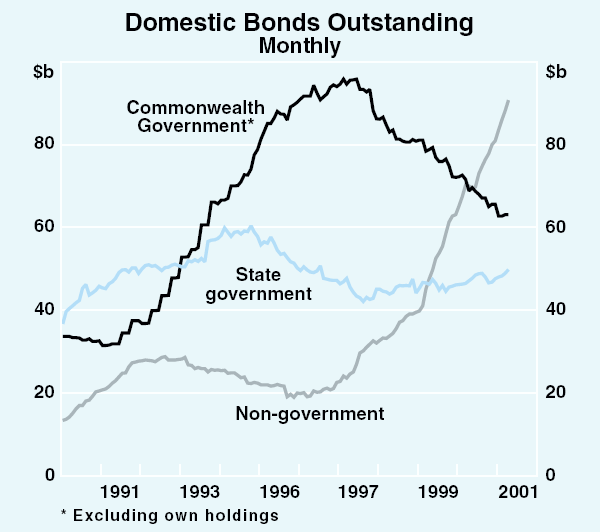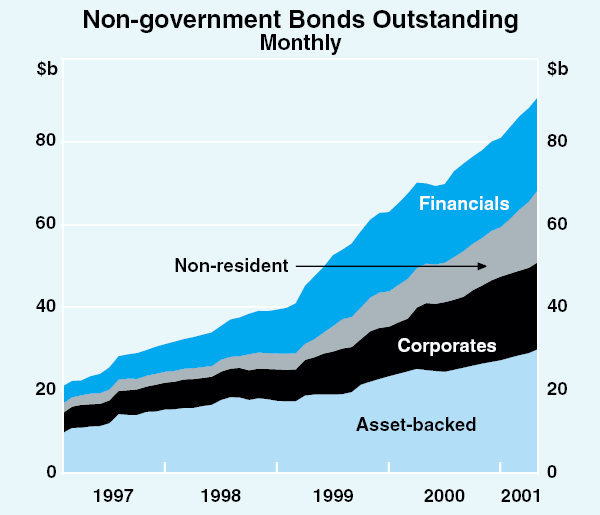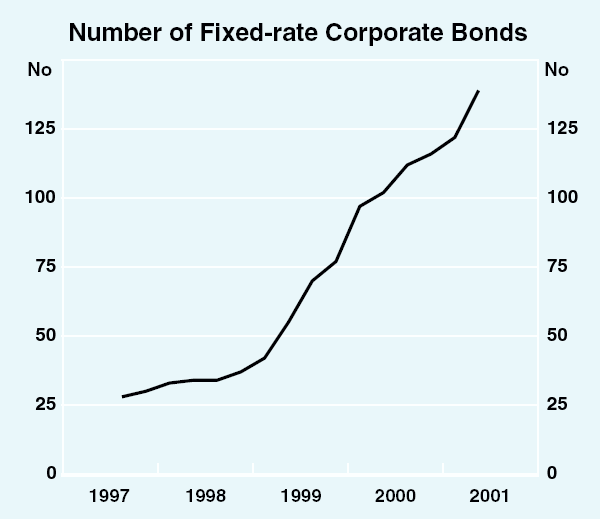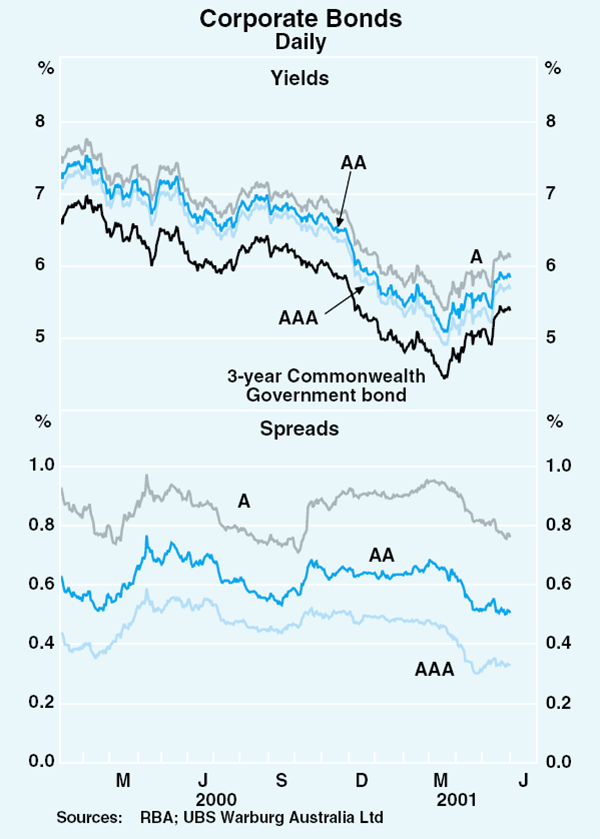Bulletin – June 2001 Corporate Bond Yields in Australia
- Download 79KB
The corporate bond market in Australia has developed quickly in recent years as large companies have moved from borrowing from banks and other financial intermediaries to obtaining financing directly from capital markets. In part this is a reflection of a global trend, but it has been hastened domestically by the strong demand for fixed-income investments from an expanding funds management industry and a falling supply of government bonds.
The Reserve Bank began publishing data on outstandings of corporate bonds in July 1999. From this month, it will supplement these with data on both the level of corporate bond yields and the spread between those yields and yields on Commonwealth Government bonds of equivalent maturity (in Bulletin Table F.3).
This article provides some background information on the non-government bond market and describes the corporate bond yield data that the Bank is beginning to publish.
Corporate Bonds Outstanding
The size of the non-government bond market in Australia stood at $91 billion at end April, more than four times its size five years earlier and well above the current levels of Commonwealth and State government bonds on issue in Australia (Graph 1). In fact, the size of the non-government bond market, in terms of the face value of bonds, is now almost as large as the Commonwealth Government bond market at its peak in 1997.

The non-government bond market can be broken down by four broad types of issuer (Graph 2): asset-backed[1] \(with $30 billion outstanding), banks and other financial corporations ($22 billion outstanding), non-residents ($17 billion outstanding), and other (i.e. corporate and public trading enterprises with $21 billion outstanding). In looking at data on yields, a distinction can be drawn between the asset-backed bonds (which tend to be mainly floating rate) and the rest, which are largely fixed-rate (i.e. bonds that pay a constant coupon interest rate through their life). The yield data provided in the new table relate to the latter type of bonds. The number of individual fixed-rate corporate bonds which are regularly traded and for which price information is available has increased from 30 in 1997 to 139 at present (Graph 3). The aggregate value of these bonds is $43 billion.


An examination of the composition of these bonds shows that:
- of the 139 bond issues, 37 per cent were issued by corporate and public trading enterprises and 35 per cent were issued by banks and other financial corporations. Non-resident issues make up the remaining 27 per cent. Many issuers have more than one issue outstanding, and as a result there are 87 separate issuers with bonds outstanding in the market;
- credit ratings (using Standard and Poor's ratings) are spread fairly evenly across the broad investment-grade ratings categories, apart from the small number of BBBs. Non-resident issues tend to have the highest ratings (AAA or AA). Bank and financial issues tend towards AA ratings (the largest issuers, the major banks, are in this rating band). Most corporate issues are A-rated. Overall, the credit quality of corporate bonds is relatively high in Australia, with all bonds being issued at investment grade. The Australian market has not seen any issuance of sub-investment grade bonds (rated BB or lower) or junk bonds as they are termed;
- maturity is concentrated at the shorter end of the yield curve. Over half the bonds on issue have a maturity of less than 3 years. Only 11 bonds, accounting for 9 per cent of outstandings, have a maturity greater than 6 years. Lower-rated bonds tend to have a shorter maturity. Many bonds have maturity dates that coincide with the maturity of benchmark Commonwealth Government bonds.
The Yield Data
Corporate bonds are traded in an ‘over-the-counter’ market in Australia, with about ten financial institutions prepared to make a market (i.e. these dealers post yields at which they stand ready to buy and sell these bonds). End-of-day interest rate information on regularly traded corporate bonds is readily available from a number of these market-makers. The yields listed at the close of business do not necessarily reflect trades but are the midpoint between the rates at which the market-maker is willing to buy and sell.
| By issuer | By credit rating | By maturity | ||||||||
|---|---|---|---|---|---|---|---|---|---|---|
| No | Value ($b) | No | Value ($b) | No | Value ($b) | |||||
| Banks and other financial corporations |
AAA | 43 | 17.9 | 0 < 1 yr | 24 | 6.6 | ||||
| 49 | 18.4 | AA | 31 | 9.8 | 1 < 2 yrs | 26 | 8.5 | |||
|
Corporate and public trading enterprises |
A | 55 | 14.2 | 2 < 3 yrs | 28 | 9.2 | ||||
| 52 | 11.6 | BBB | 10 | 1.5 | 3 < 4 yrs | 21 | 6.3 | |||
| Non-resident | 38 | 13.3 | 4 < 5 yrs | 25 | 7.6 | |||||
| 5 < 6 yrs | 4 | 1.5 | ||||||||
| ≥ 6 yrs | 11 | 3.7 | ||||||||
| Total | 139 | 43.3 | 139 | 43.3 | 139 | 43.3 | ||||
The representative yields presented in Bulletin Table F.3 are based on this dealer information and are weighted averages (based on the face value of each bond). Disaggregation of the yield data is provided only by credit rating. There are, as yet, not a sufficient number of bonds on issue to allow further disaggregation by industry and term to maturity. It is hoped that the degree of detail shown in Table F.3 can be expanded as the Australian bond market continues to grow.
Graphs 4 and 5 show the series presented in Bulletin Table F.3. The top panels show average yields of corporate bonds with AAA, AA and A credit ratings, and with a remaining maturity of 2 years and up to 4 years. For comparison purposes, these panels also show the yield on 3-year Commonwealth Government bonds. The bottom panels show the average spread or difference of the corporate bond yields relative to government bonds of the same maturity. While day-to-day movements in corporate bond and government yields are highly correlated, corporate bonds trade at higher yields than government bonds. This spread reflects perceptions about the credit risk and the fact that the market for these bonds is less liquid than the government bond market. Movements in the spread result from changing perceptions about these market characteristics and therefore can provide useful information about financial conditions.


Footnote
Asset-backed bonds are issued by special-purpose vehicles registered to securitise assets such as residential and commercial mortgages, lease finance receivables and other loans. [1]